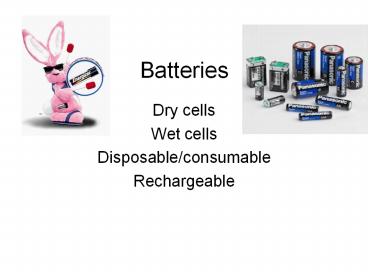Batteries - PowerPoint PPT Presentation
1 / 17
Title:
Batteries
Description:
Through experimentation, Volta realized that the two different metal objects ... Volta modified this effect to produce the first continuous flow of electric current. ... – PowerPoint PPT presentation
Number of Views:451
Avg rating:3.0/5.0
Title: Batteries
1
Batteries
- Dry cells
- Wet cells
- Disposable/consumable
- Rechargeable
2
Alessandro Volta the first battery
- In 1800, he built the first electrical pile, or
battery a series of metal disks of two kinds,
separated by cardboard disks soaked with acid or
salt solutions. This is the basis of all modern
wet-cell batteries. It was a tremendously
important scientific discovery because it was the
first method found for the generation of a
sustained electrical current.
3
How Volta got the idea
- The idea came from Luigi Galvani, an anatomist.
Galvani was dissecting a (dead) frog when the
frog's leg began to twitch. Galvani thought was
because of some type of electrical action in the
vicinity, such as lightning. Volta successfully
duplicated the experiment on a clear day when
there was no lightning.
4
Voltas first battery
- Through experimentation, Volta realized that the
two different metal objects holding the frog leg
might be the source of the action. Over a period
of several years he worked out that the wet
muscle tissue conducted a current between the two
different types of metals. Volta modified this
effect to produce the first continuous flow of
electric current. Around 1800, he invented a wet
battery called a Voltaic Pile.
5
Two kinds of batteries
- Dry Cellslike D, C, AAA, AA, 9 volt, etc.
- Not really dryinsides contain an ion
transferring material which is a paste-like
material. - Wet cellslike car batteries
- Slosh around (sulfuric acid is the ion
transferring material)
6
2 kinds of dry cells
- Disposable/consumable The ones you replace when
they are dead. - Rechargeable The ones you plug into the wall
outlet to recharge. More expensive to purchase
but last a fairly long time (but they dont last
forever!). - Both can be re-cycled In East Brunswick, Best
Buys, Office Depot, and Radio Shack are
collection sites.
7
Dry cells Carbon-Zinc Cells
Applications Clocks Communications
Equipment Electronic Calculators
Flashlights, Penlights Measuring
Instruments Remote Controls Portable
Electronics Have mostly been replaced by
alkaline batteries.
8
Carbon-zinc battery
This arrangement is about the same for most
cylindrical batteries. The chemicals inside will
change, depending on type.
9
Dry Cells Alkaline Cells
- These cells are similar to carbon-zinc but have
much longer shelf life than carbon-zinc and
perform better under drain and in cold weather.
They use a different ion transfer paste that
avoids the use of the zinc-corroding ammonium
ions and does not produce any gaseous products.
These are less likely to leak. Lew Urry developed
the small alkaline battery in 1949. The inventor
was working for the Eveready Battery Co. in
Parma, Ohio. Alkaline batteries last five to
eight times as long as zinc-carbon cells, their
predecessors.
10
Alkaline Batteries
- Applications
- Cameras
- Electric shavers
- Electronic calculators
- Electronic door locks
- Fire detectors
- High-power flashlights
- Pagers
- Strobes
- Tape recorders
- Toys
- Other cordless products
These are sold in both the disposable and
re-chargeable types.
11
Wet Cell Lead-Acid Battery
The reaction of lead and lead oxide with the
sulfuric acid electrolyte produces a voltage. The
supplying of energy to an external resistance
(like to run a car) discharges the battery.
12
Wet Cell Lead-Acid Battery
Most economical for larger power applications
where weight is of little concern. Preferred
choice for hospital equipment, wheelchairs,
emergency lighting, as well as car batteries.
13
Other Dry Cells NiCd
- Nickel-Cadmium (NiCd) Used where long life,
high discharge rate, and economical price are
important. Main applications are two-way radios,
biomedical equipment, professional video cameras,
and power tools. Should be periodically
discharged completely and then re-charged.
Cadmium is toxic and environmentally unfriendly.
Recycle!
14
Other Dry Cells NiMH
- Nickel Metal Hydride (NiMH) Due to their
increased capacity and energy density features,
users can expect a longer time between charges
and longer running time. NiMH contain no toxic
metals. Applications include mobile phones and
laptop computers. Experts feel that applying a
full discharge once every three months seems
right. Because of the NiMH batterys shorter
cycle life, over-exercising (discharge/re-charge)
is not recommended.
15
Other Dry Cells Li-ion
- Lithium-ion (Li-ion) Fastest growing battery
system used where high-energy density and light
weight is of prime importance. This one is more
expensive than other systems and must follow
strict guidelines to assure safety. Not sold off
the shelf but used in audio visual equipment,
cellular phones, Notebook PC's, PDA's and handy
terminals. Keep cool, but not frozen (do not
store in a hot car), charge often avoiding deep
discharges.
16
Other Dry Cells Li-ion polymer
- Lithium-Ion Polymer (Li-ion polymer) A
potentially lower cost version of the Li-ion and
has similar chemistry. It enables very slim
geometry and allows simplified packaging. Main
applications are mobile phones. - Lithium type batteries are constantly changing
and improving as various internal chemicals are
tried. Stay tuned!
17
Take a battery quiz
- http//www.rediff.com/money/2005/may/26quiz.htm































